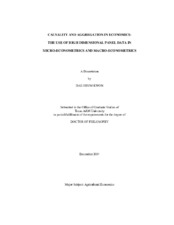| dc.description.abstract | This study proposes one plausible procedure to address two methodological issues,
which are common in micro- and macro- econometric analyses, for the full realization of
research potential brought by recently available high dimensional data. To address the issue of
how to infer the causal structure from empirical regularities, graphical causal models are
proposed to inductively infer causal structure from non-temporal and non-experimental data.
However, the (probabilistic) stability condition for the graphical causal models can be violated
for high dimensional data, given that close co-movements and thus near deterministic relations
are oftentimes observed among variables in high dimensional data. Aggregation methods are
proposed as one possible way to address this matter, allowing one to infer causal relationships
among disaggregated variables based on aggregated variables. Aggregation methods also are
helpful to address the issue of how to incorporate a large information set into an empirical model,
given that econometric considerations, such as degrees-of-freedom and multicollinearity, require
an economy of parameters in empirical models. However, actual aggregation requires legitimate
classifications for interpretable and consistent aggregation.
Based on the generalized condition for the consistent and interpretable aggregation
derived from aggregation theory and statistical dimensional methods, we propose plausible
methodological procedure to consistently address the two related issues of causal inference and
actual aggregation procedures. Additional issues for empirical studies of micro-economics and
macro-economics are also discussed. The proposed procedure provides an inductive guidance for
the specification issues among the direct, inverse, and mixed demand systems and an inverse
demand system, which is statistically supported, is identified for the consumer behavior of soft
drink consumption. The proposed procedure also provides ways to incorporate large information
set into an empirical model with allowing structural understanding of U.S. macro-economy, which was difficult to obtain based on the previously used factor augmented vector
autoregressive (FAVAR) framework. The empirical results suggest the plausibility of the
proposed method to incorporate large information sets into empirical studies by inductively
addressing multicollinearity problem in high dimensional data. | en |


